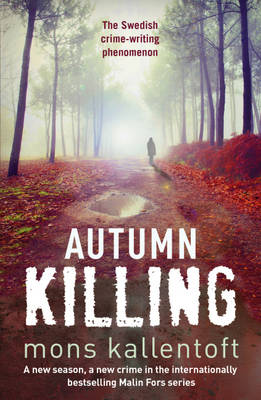
EURO CRIME
Reviews

Kallentoft, Mons - 'Autumn Killing' (translated by Neil Smith)
Paperback: 512 pages (Sep. 2012) Publisher: Hodder Paperbacks ISBN: 1444721623
The third in the series about Malin Fors and her colleagues of the police in Linkoping, a small town in Sweden south of Stockholm, continues the themes raised in the first two books. Jerry Peterson, an IT millionaire, has bought the local castle from the aristocratic Fagelsjo family, who have owned the estate for centuries but who have fallen on hard times thanks to incompetent financial speculation. Peterson is found dead in the moat of the castle, so a police investigation is launched. As we have come to expect from this author, Jerry's dead body attempts to communicate with Malin (in italics, naturally) to urge her to find out who killed him. He doesn't provide enough information to be practically useful, so Malin and team have to resort to the more traditional methods of investigating the Fagelsjos as well as Peterson's life and finances - a thankless task as the man seemed to have no friends or anything irregular in his business accounts, though he had once acted as an advisor to a fraudster who is now living in Tenerife.
As well as the investigation, the novel focuses on the personal lives of the cops, mainly Malin, who is falling to pieces in a spectacular way as her alcoholism spirals out of control. Out of misguided kindness or a conviction that she'll solve the case, her colleagues and family try to cover up the extent of her disintegration. Malin has in addition become obsessed with the case of a catatonic woman she encountered in the first book in the series, though all she does about it here is to read through the case notes several times.
Eventually, the Peterson case is solved with the aid of a couple of standard devices such as a second murder and the eventual discovery of a file among the victim's papers that nobody had previously opened. The solution is solid as a mystery, but as with the earlier series books, the novel is twice as long as it needs to be. Far too much space is devoted to inconclusive scenes of Malin drunk and not coping (including an abortive attempt to confront her mother), and to flashbacks or passages about Peterson's post-mortem ramblings. Hence the book loses focus about half-way through, particularly given the idiosyncratic writing style, with paragraphs of a few words and points repeated several times, as well as rather too many autumnal allusions.
There are many good things about this book: the early scenes of Malin's alcoholism are compelling, reminiscent of Harry Hole in Jo Nesbo's THE REDBREAST. But with insufficient development of Malin's or any of the other characters' lives and dilemmas, the book stands or falls on the murder mystery itself - which could easily have been told in 250 pages rather than 500. Presumably, in the fourth and last book in the series, the various threads of Malin's state of mind, her guilt about her daughter, her parents' behaviour, and the case that haunts her will all be resolved - but I feel that to maintain tension, these elements should have been advanced through the previous books rather than the same information being repeated each time.
Maxine Clarke, England
November 2012
Details of the author's other books with links to reviews can be found on the Books page.
More European crime fiction reviews can be found on the Reviews page.